Pitching Mechanics Analysis
Michael Wacha
I fell in love with Michael Wacha's pitching mechanics due to
his spectacularly efficient core; a core that is an almost
perfect clone of Justin Verlander's.

Michael Wacha
However, as time went by, and Michael Wacha's velocity went
up relative to his days at Texas A&M, I noticed something; his
arm was getting later and later and his
Timing was getting worse and worse.
Now, when I look at Michael Wacha, I still see that
spectactularly efficient core but I also see a hugley
problematic movement pattern that I call
Flat Arm Syndrome and that makes me relatively pessimistic
about his future prospects.
What Happened?
If you follow my work, you know that I had — and to a degree
still have — a high opinion of Cardinals pitcher Michael Wacha.
He possesses many of the characteristics that I look for in a
pitcher; athleticism, efficiency, etc.

Michael Wacha
For instance, this picture of Michael Wacha is pure gorgeousity.
It's also pretty much functionally identical to one of my favorite pictures of
Justin Verlander, one of my favorite pitchers.

Justin Verlander
As a result, I was surprised when Michael Wacha went down with a stress
reaction in his scapula.
What happened?
I think the answer to that question is tied into a concept
that many people in and around baseball throw around but that I
believe is
becoming increasingly problematic.
The Problem with Projectability
If you listen to scouts enough, one word that you will hear
tossed around a lot is the word, "Projectable." Essentially,
when a scout says a player is projectable, it means that
player has room for significant improvement.
For hitters, that often means that they have the
potential to hit for more power in the major leagues. For
pitchers, that generally means that they have the potential to
throw harder than they currently do.
On the one hand, I get the concept of projectability; many
people have room for improvement. Their mechanics aren't
perfect and you can see things that, if cleaned up,
could help them achieve a higher level of performance.
The problem I have with the concept of projectability,
for pitchers at least, is that in many cases the way
that pitchers are achieving the velocity improvements that make
them "projectable" is through the use of any number of
problematic tricks and
shortcuts, many of which I discuss in The Epidemic,
my webbook on the pitcher injury epidemic.1
I have direct knowledge of this problem.
A year or so a client of mine, an affiliated minor league,
left-handed pitcher who can throw 90 to 91 was told by his
coaches that by learning to make the
Inverted W, he could pick up a few more miles per hour. The
problem is that my client was not informed of the risks of
making such a change, just the benefits.
In the case of Michael Wacha, the primary trick that he seems
to be employing is
Scapular Loading, although I also see some suggestion that
he may also be trying to
Show the Ball to Center Field.
Regardless of exactly which trick(s) Michael Wacha is employing,
I have found that, under certain
circumstances, his arm is getting into a problematic
position. I believe that is contributing to the overloading of
the muscles that attach to his scapula and creating the stress
reaction that he is experiencing.
Michael Wacha 1.0
The scouting reports I've read on Michael Wacha in college
put his fastball the 90-94 range in college. Yes, some people
had him toppping out at 95 or 96, but touching 96 in a bullpen
isn't the same as sitting 96 in a game.
The video clips that I have seen of Michael Wacha pitching in
college do not show any signs of a timing or other problem.
Instead, I see everything that I look for in a prospect and
rated Michael Wacha very highly as a result.

Michael Wacha
Fastball
The same is true of the few still images that I have been able to
find.

Michael Wacha
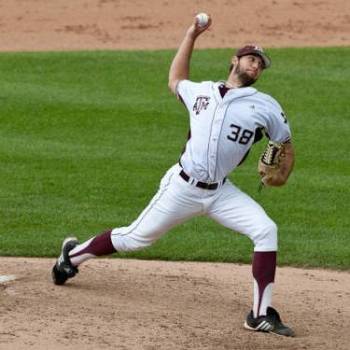
Michael Wacha
What you see is an arm that is up and in a good position at
foot strike. You also see the telltales of mechanical
efficiency.
Michael Wacha 2.0
The first hint of a problem with Michael Wacha's
pitching mechanics came during the World Series. During one of
the broadcasts, they showed some high speed footage of Michael
Wacha throwing a pitch.
This clip is problematic for two reasons. First, this clip is
stripped of context; you don't know what pitch this was or how
hard it was thrown. Second, although it doesn't show Michael
Wacha's feet, if you look at this clip closely, you will see
hints of a timing problem.
The thing to notice is the position of Michael Wacha's arm
when his hips start rotating.
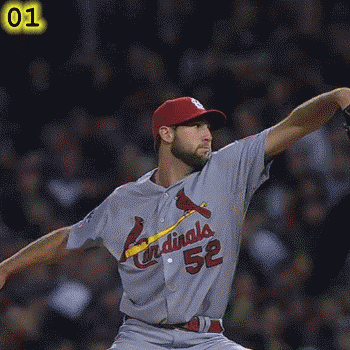
Michael Wacha
Although it's hard to judge precisely, because you can't see Michael
Wacha's feet, I'd estimate that his hips start rotating in Frame
32. That is a problem because only a few frames earlier, in
Frame 29, Michael Wacha is at the point of maximum scapular load
and his pitching arm is at roughly zero degrees of external
rotation and perpendicular to his spine.
Three frames isn't enough time for Michael Wacha's pitching
arm to externally rotate 90 degrees.
As a result, his arm
externally rotates up and back while his hips and shoulders
rotate. That will tend to put more load on his elbow and
shoulder.
So is His Timing Good or Bad?
The odd thing about Michael Wacha is that for every picture
that you can find in which his arm is in a problematic position and
exhibiting a
timing problem...
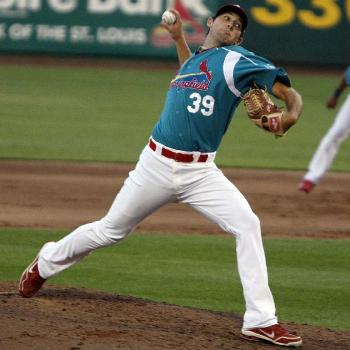
Michael Wacha
...you can find another picture of him in a good position,
with his arm at roughly 90 degrees of external rotation at foot
plant.

Michael Wacha
I initially believed that what I was seeing were just two
different moments in time during the same delivery; that Michael
Wacha was just very good at holding his shoudlers back in order
to give his arm time to get up.
However, Michael Wacha's problems with his
scapula made me re-evaluate things. That helped me discover
something that I believe that is causing Michael Wacha's timing
to vary and that is contributing to his shoulder problems.
Let's Go to the Tape
During early 2014, pretty much right from the start of the year, I
started to see what looked like some variability in Michael
Wacha's timing. In some clips, and when throwing some pitches,
he would look fine. However, in other cases he looked a bit off.
I started paying close attention to Michael Wacha's timing on April 24, 2014 when I
read that he said...
"I was able to go back there and look at the film there in
the fourth inning," Wacha said. "Mechanically there my arm was
dragging, forcing me to yank the ball. I wasn't really in sync
there."
His comments have all of the hallmarks of someone who is
struggling with a timing problem. As a result, I made a point of going to
every start that Michael Wacha threw and tried to film him from
multiple angles and, more importantly, correlating those clips
with Pitchf/x data.
On May 15, 2014, I hit what I later found was paydirt.
I was playing around with a new camera — a high speed camera
with a big zoom lens — and managed to capture the following
sequence of images. The thing to notice is that, as he throws
harder, Michael Wacha's degree of scapular loading (retraction)
increases and his external rotation decreases (his arm is
flatter at the same moment in time).
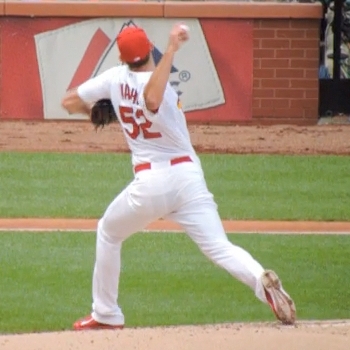
Michael Wacha
94 MPH Fastball
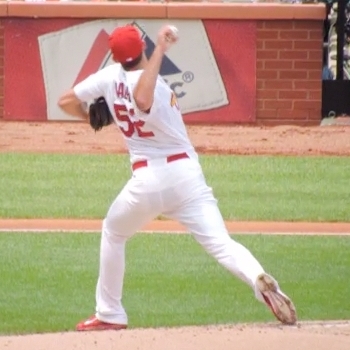
Michael Wacha
94 MPH Fastball
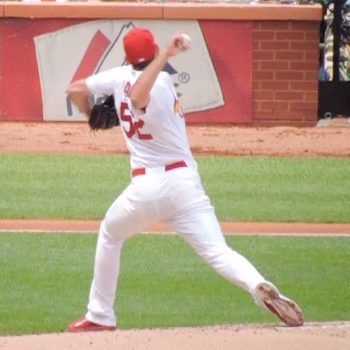
Michael Wacha
96 MPH Fastball
If you compare the two pictures directly above, you will
notice how you can see much less of Michael Wacha's name on the
back of his jersey. What you are seeing is an extreme retraction
and elevation of the scapula as well as a greater degree of
internal rotation; what I call
Flat Arm Syndrome, caused by the
Horizontal W.
Over-throwing
The bottom line is that I believe that Michael Wacha is
over-throwing. By trying to create more velocity, Michael Wacha
is putting his body, and especially his arm and his scapula, in
a problematic position.
You can see this same problematic position in the frame
below, which shows Michael Wacha throwing the pitch that cost
him a no-hitter with two outs in the ninth inning.
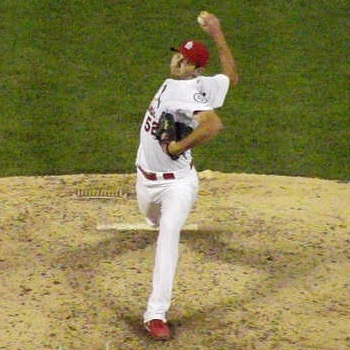
Michael Wacha
97 MPH Fastball
In an effort to blow the hitter away with a 97MPH fastball,
Michael Wacha has kept his arm back such that his arm is only
externally rotated 30 to 45 degrees at the moment that his front
foot plants and his hips and shoulders start to rotate.
My Old Nemesis, Scap Loading
I don't know what Michael Wacha has been taught and why he is
doing what he is doing. However, I do know that what Michael
Wacha is doing is something that I have come across before. It is
called
Scapular Loading and it's a popular and effective, but
potentially problematic, way of giving a pitcher a velocity
boost.

Michael Wacha

Michael Wacha
Maybe Michael Wacha is scap loading because he's been taught
to do it and maybe he just does it naturally because it
helps him throw extra hard.
Regardless, when he scap loads in an effort to take his velocity
to 11, he is pushing his body beyond its current capabilities.
It would be worth it to compare when and how Michael
Wacha scap loads to how hard throwers like Nolan Ryan and
Randy Johnson (and Trevor Rosenthal) scap loaded and look
for differences that might be significant.
It's Not the Change-Up (Grip/Release)
I have heard some talk about how Michael Wacha is using
his change-up less often. I'm not sure if that is true or what
the motivation is, but I do need to address a misconception.
I have heard people say that the change-up is problematic
because the resulting pronation can overload the shoulder. I
am skeptical about these claims because in The Epidemic I
have identified a number of
Killer Cues
that I believe do a better job of identifying why pitchers
are getting injured.
There's also the fact that a good change-up is thrown
exactly the same as the fastball. Generally, the arm action is the same and the
only difference is the grip. Given that Michael Wacha's
change-up is regarded as a plus or even plus plus pitch,
what I could buy is that he is throwing it too much like his
(hard) fastball; that when he throws a change-up, he does so
using his (problematic) 97 MPH arm action.
It could even be the case that Michael Wacha is throwing
his change-up with an even faster arm action — as he would
when throwing a 100 MPH fastball — than his fastball.
However, again the problem is the 97+ MPH arm action, and
the scapular loading, not the change-up grip.
A Few Thoughts About
Brandon McCarthy
Brandon McCarthy's name is often brought up in the context of
Michael Wacha because they both have had the same rare problem.
As it turns out, I am deeply familiar with
Brandon McCarthy's pitching mechanics because I have
discussed Brandon McCarthy's pitching mechanics a number of
times with him over the years.
While their stories are different, I believe that there
are things that helped Brandon McCarthy that could also help
Michael Wacha.
If I Ran the Zoo
If I ran the zoo and/or could talk to Michael Wacha for
15 minutes, I'd tell him that first and foremost he
needs to stop over-throwing. His velocity is what
it is right now. Combine that with his already excellent
change-up and a developing curveball and he has all of the
tools that he needs to be successful in the short term.
If Michael Wacha is still interested in boosting his
velocity, there are ways of eking out additional velocity.
However, scap loading is not the answer for Michael Wacha as
his scap stress reaction is making clear.
Notes
1. Mariano Rivera had the same
experience as Michael Wacha when he first came up. The
Yankees tried to turn him into a 95-96 MPH power pitcher, as
opposed to the 92-93 MPH pitcher that he was, and he got
hurt as a result. Mariano Rivera could only stay healthy by
focusing on command and movement, not maximum velocity.
|